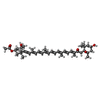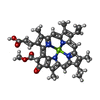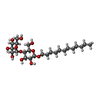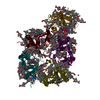+Search query
-Structure paper
| Title | Structural and spectroscopic insights into fucoxanthin chlorophyll a/c-binding proteins of diatoms in diverse oligomeric states. |
|---|---|
| Journal, issue, pages | Plant Commun, Page 101041, Year 2024 |
| Publish date | Jul 17, 2024 |
 Authors Authors | Cuicui Zhou / Yue Feng / Zhenhua Li / Lili Shen / Xiaoyi Li / Yumei Wang / Guangye Han / Tingyun Kuang / Cheng Liu / Jian-Ren Shen / Wenda Wang /   |
| PubMed Abstract | Diatoms, a group of prevalent marine algae, significantly contribute to global primary productivity. Their substantial biomass is linked to enhanced absorption of blue-green light underwater, ...Diatoms, a group of prevalent marine algae, significantly contribute to global primary productivity. Their substantial biomass is linked to enhanced absorption of blue-green light underwater, facilitated by fucoxanthin chlorophyll a/c-binding proteins (FCPs), exhibiting oligomeric diversity across diatom species. Utilizing mild CN-PAGE analysis on solubilized thylakoid membranes, we displayed monomeric, dimeric, trimeric, tetrameric and pentameric FCPs in diatoms. Mass spectrometry analysis revealed each oligomeric FCP has specific protein compositions, constituting a large Lhcf family of FCP antennas. In addition, we resolved the structures of Thalassiosira pseudonana FCP (Tp-FCP) homotrimer and Chaetoceros gracilis FCP (Cg-FCP) pentamer by cryo-electron microscopy at 2.73 Å and 2.65 Å resolutions, respectively. The distinct pigment composition and organization in various oligomeric FCPs change their blue-green light-harvesting, excitation energy transfer pathways. In comparison to dimeric and trimeric FCPs, Cg-FCP tetramer and Cg-FCP pentamer exhibit stronger absorption by Chls c, red-shifted and broader Chl a fluorescence emission, as well as more robust circular dichroism signals originating from Chl a-carotenoid dimers. These spectroscopic characteristics indicate that Chl a molecules in Cg-FCP tetramer and Cg-FCP pentamer are more heterogeneous than in both dimers and Tp-FCP trimer. The structural and spectroscopic insights provided by this study contribute to a better understanding of the mechanisms that empower diatoms to adapt to fluctuating light environments. |
 External links External links |  Plant Commun / Plant Commun /  PubMed:39030906 PubMed:39030906 |
| Methods | EM (single particle) |
| Resolution | 2.65 - 2.73 Å |
| Structure data | EMDB-36466, PDB-8jp3: EMDB-37441, PDB-8wck: EMDB-37442, PDB-8wcl: |
| Chemicals |  ChemComp-A86:  ChemComp-CLA:  ChemComp-KC2:  ChemComp-KC1:  ChemComp-LMG:  ChemComp-LMT: |
| Source |
|
 Keywords Keywords | PHOTOSYNTHESIS / FCP trimer / FCP tetramers / FCP pentamer in Chaetoceros gracilis |
 Movie
Movie Controller
Controller Structure viewers
Structure viewers About Yorodumi Papers
About Yorodumi Papers









 thalassiosira pseudonana ccmp1335 (Diatom)
thalassiosira pseudonana ccmp1335 (Diatom)